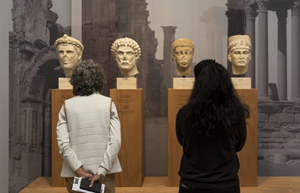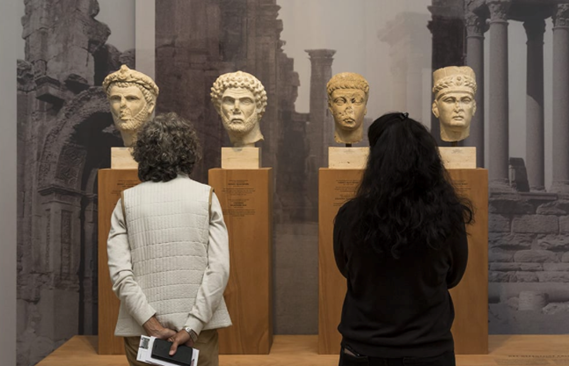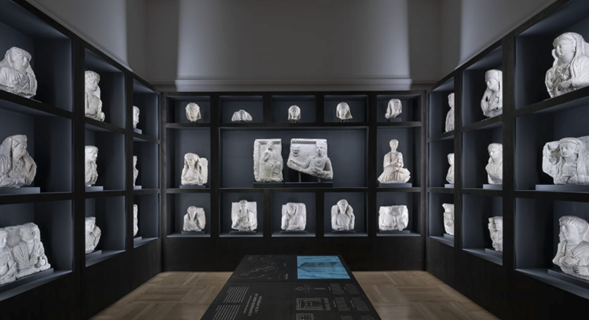
The Road to Palmyra is the first special exhibition in Denmark devoted to the culture of ancient Palmyra – an oasis city located in present-day Syria.
Image courtesy for the Glyptoteket
The Road to Palmyra is the first special exhibition in Denmark devoted to the culture of ancient Palmyra – an oasis city located in present-day Syria.
In a time when globalisation, migration and cultural conflict permeate the agenda in many places in the modern world, Palmyra has again attracted attention with its fascinating history as one of the ancient world’s multicultural societies.

Image courtesy for the Glyptotek
It was located at the Efqa Spring in the Syrian Desert halfway between the Euphrates and the Mediterranean. The oasis city was a natural nodal point between trade and caravan routes. And a centre for the exchange of both goods and cultures between East and West; at the same time the city was the easternmost bastion of the Roman Empire. With this background it became a vibrant meeting point for various cultures. Many caravans travelled through the city. They brought silk from China; cotton, spices, jewellery and dyestuffs from India; ivory from Africa; myrrh and incense from Arabia and wine, metals and glass from the West. It is also in Palmyra that we encounter the story of the legendary queen, Zenobia.
A unique collection comes to life
This exhibition takes the Glyptotek’s unparalleled collection of ancient tomb sculptures from the city as its point of departure. The more than 100 portraits included in the exhibition are supplemented by sculptures and other items from the Roman Empire, photographs from the 19th century, paintings and much more, together creating a broad presentation of Palmyra’s special history in an exhibition designed by the renowned Danish designer and scenographer Anne Schnettler in collaboration with graphic designer Nanna Arnfred.
The antique items are furthermore being brought to life through the sounds of the oasis. The soundscape has been designed for the exhibition by award-winning sound designer Peter Albrechtsen and film director Sun Hee Engelstoft.
One installation in the exhibition will take the form of a Palmyrene burial chamber: here visitors will get a sense of how it must have felt to enter one of Palmyra’s tombs in the early centuries of our era.
The Glyptotek has a long history of research into the original painting of ancient sculptures. In connection with the exhibition, the research team has examined one of the main pieces in the collection, “The Beauty of Palmyra”. Based on the results of these examinations the researchers have created a digital reconstruction of the portrait. This gives visitors an idea of how the beauty might have looked in her heyday.
The current conflicts in Syria have brought about a renewed focus on the value of the unique cultural heritage in the area. This exhibition focuses on the first three centuries CE, when the city played an important role locally, regionally and globally, not least in relation to the Roman Empire. The Glyptotek’s tomb portraits constitute an important and specific aspect of the city’s cultural monuments. Today many of the city’s cultural artefacts have been destroyed or have been sold illegally market. Many of these upheavals being caused by the terrorist group ISIS. They invaded the city in 2015, blew up ancient ruins and monuments and plundered the area for objects of value.

Image courtesy for the Glyptotek
The Glyptotek’s collection of Palmyrene portrait sculptures, the largest outside Syria, has in recent years been the point of departure for the comprehensive research undertaking, the “Palmyra Portrait Project” at Aarhus University. The Road to Palmyra has been partly based on knowledge gained from this research and Professor Rubina Raja, leading the project, has acted as consultant in the creation of the exhibition.
Palmyra has over time been described in Jewish, Arabic and ancient texts, often focusing on the city’s famous Queen Zenobia. In modern times Zenobia has also been described and interpreted in literature, the visual arts, music and film. In the exhibition we present a number of different representations of Zenobia. These also constitute examples of the Western view of the “East” and have characterised the story of Palmyra since the city was “rediscovered” in the 18th century by the two Englishmen, Dawkins and Wood.
The story of how the portraits ended up in the Glyptotek will also be presented in the exhibition. Among other things through the extensive correspondence between the founder of the museum, Carl Jacobsen and the Danish Consul in Beirut Julius Løytved. They were close friends in the 1880s and 1890s when the greater part of the collection was acquired.
This and other aspects of the story of Palmyra are dealt with in a comprehensive catalogue including contributions from several Danish and international researchers.
Much of the collection has, since the spring of 2018, been lent to The J. Paul Getty Museum in USA, where it is on exhibition. These sculptures are all scheduled for return to the Glyptotek for the forthcoming exhibition.
The research project, “Palmyra Portrait Project” and the polychromy research are supported by the Carlsberg Foundation.
Until 1 March, 2020

ArtDependence Magazine is an international magazine covering all spheres of contemporary art, as well as modern and classical art.
ArtDependence features the latest art news, highlighting interviews with today’s most influential artists, galleries, curators, collectors, fair directors and individuals at the axis of the arts.
The magazine also covers series of articles and reviews on critical art events, new publications and other foremost happenings in the art world.
If you would like to submit events or editorial content to ArtDependence Magazine, please feel free to reach the magazine via the contact page.